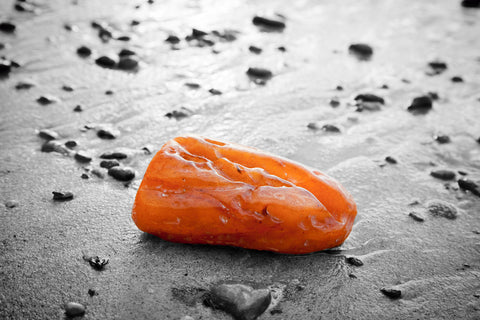Posted on 07 June 2017
Both adults and children have worn amber necklaces for centuries. While many still believe that the substance is a mineral or a crystal in actuality Amber is hardened resin, which dropped from the trunks of now-extinct conifers millions of years ago and solidified over time. The gem has been used by humans for roughly 35,000 years, as it was first seen washed up on the shores of land surrounding the Baltic Seas.
The material was then transported to other parts of Europe via the “Amber Road,” a trade route connecting the coastal areas of the North and South Baltic Seas down to the Mediterranean Sea. The gem was mainly used for its alleged medicinal properties, to alleviate pain, treat various diseases. Although previous generations have claimed that Amber has effective healing elements, it was only until recently that modern-day scientists proved this theory to be true.
Amber’s Genetic Make-up
Amber is comprised of hydrocarbon, plant materials, succinic acid and a mishmash of tree resins from different types of conifers, such as the extinct Hymenaea species and Pine genus. The resin is not to be confused with tree sap, which courses through the body of the tree intravenously. Rather, Resin is a thick fluid that slid down the tree’s exterior, as a way to ward of injury and threats of disease by filling in crevices.
Once the resin made its way down the side of a tree, it fell in clumps to the ground where it hardened over time. Resin is also said to be the remains of trees that were affected by various geological events, which caused them to be uprooted and carried away by rivers to coastal regions. Hundreds of years later, the trees have been eroded, and the resin remains.

However, it takes millions of years for the resin to turn into Amber. The material must undergo a polymerization process, which links resin molecules together to form larger molecules and forces the substance to harden further. In fact, the world’s Amber is roughly 30 to 90 million years old, which gives you an idea of how long the polymerization process takes. The resin that has not fully emerged from the hardening process is softer in consistency and referred to as “Copal.”
Most Copal can be found in the Mesoamerican region, as the matter comes from a tree named Protium copal, which is prominent in that area. Buyers who are interested in purchasing authentic amber should know how to differentiate real amber from Copal. One easy method is to put a drop or two of acetone or alcohol on the material in question; if the material becomes sticky, then it is copal and not amber.
The History of Amber Necklaces
The history of amber necklaces dates back centuries. Even Hippocrates, the father of medicine, believed that Baltic amber had healing powers when worn. For years amber beads were placed on a string and worn by children because people believed that the gemstone would reduce the pain associated with the teething process.
The gemstone was also used by various civilizations over the years to cure different ailments. Outside of being worn, Amber was also ground into a powder and mixed with other substances (e.g., different oils or honey) to create a salve that was said could cure anything from asthma to epilepsy. Amber was even burned as incense to disinfect certain areas.
Outside of the healing aspects of Amber, the gemstone was also used to adorn everything from jewelry to palace walls because of its beautiful and unique coloring. Frederick I of Prussia famously commissioned for an amber room to be built in the early 18th century as a way to display the beautiful gem that was native to his empire.
The Science Behind Baltic Amber’s Healing Properties
Baltic amber contains up to 8% succinic acid, which has analgesic qualities. This means that Baltic amber has anti-inflammatory and pain-killing properties, and can even heal those suffering from respiratory diseases or infections. The succinic acid sits on the surface of the stone and when the gem is warmed up the succinic acid is released.
For babies going through the teething process, all they have to do is wear a Baltic amber necklace, which their body heat warms up, thereby releasing the succinic acid. Since the necklace is resting close to your child’s skin, the succinic acid is then absorbed into their body, and they are able to reap all of the healing benefits of the amber necklace.
The amazingly positive effect that succinic acid has on the human body has been researched and proven by the Nobel Prize-winning scientist, Robert Koch, who studied succinic acid closely in the late 19th century. This scientific find makes sense considering that Amber is hardened resin, a substance that functioned as an antibiotic for an organic organism.
Also, Amber is an electronegative substance, which means that it generates negative ionization. Negative ionization is known to be associated with several health benefits, such as protection from various illnesses and causing a positive change in one’s mood. These effects make Amber, and more specifically, Baltic amber an ideal remedy to help your child during the teething process. This means that you can forgo dangerous over-the-counter medications and opt for an all-natural, non-toxic antidote.
Conclusion
It’s clear that there is more to a Baltic amber necklace than wearing its many honey-colored hues for fashion purposes. The necklace is comprised of hardened resin that contains succinic acid, which has been proven to harbor healing properties. Even before the more recent scientific discovery of amber’s restorative properties, the gemstone was used for centuries as a cure-all element in many different societies.
Also, amber necklaces are natural and non-toxic, which is ideal for parents who tend to choose organic or homeopathic remedies over prescribed or over-the-counter medications. By choosing an amber teething necklace you no longer have to worry about the side effects associated with conventional teething remedies, such as teething gels. These facts make the Baltic amber teething necklace a fashionable and functional accessory for your little one.





